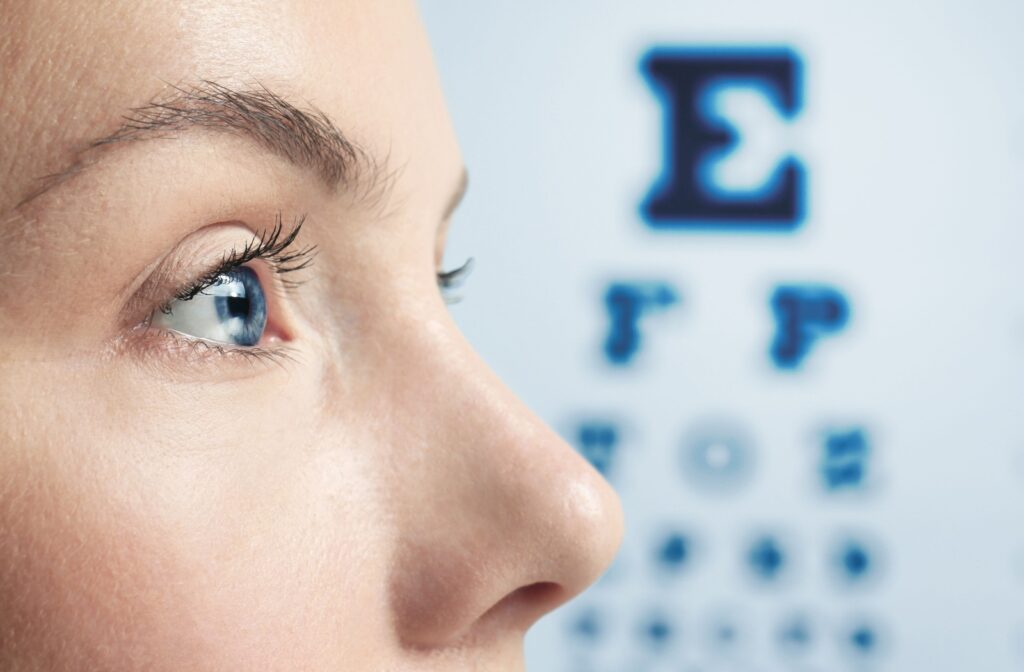Vision is one of the ways we can explore and experience the world around us. Not everyone experiences clear vision throughout their life. Many individuals have some form of refractive error, resulting in blurry vision.
Myopia and hyperopia are two of the most common refractive errors and can reasonably be described as opposites of one another.
Myopia results in blurry distance vision while vision close by remains clear. Hyperopia results in clear-distance vision while nearby vision is blurry.
What is Myopia?
Myopia, commonly known as nearsightedness, is a refractive error where distant objects appear blurry while objects close by can be seen clearly. It’s estimated that 30% of Canadians are myopic.
This can lead to difficulty seeing things at a distance and impact daily activities like driving, watching TV, learning, and recognizing faces from afar.
Symptoms of myopia may include:
- Squinting to see clearly
- Eye strain or headaches
- Difficulty seeing during nighttime
- Needing to sit closer to the TV or the front of the classroom
How Does Myopia Impact Vision?
In an eye with no refractive error, the shape of the eye is round. Light enters the eye through the lens and is refracted by the cornea, which focuses the light directly on the retina, resulting in clear vision.
In an eye with a myopic refractive error, the shape of the eye is slightly elongated instead of round. When light enters the eye through the lens and is refracted by the cornea, light focuses in front of the retina, resulting in blurry distance vision.
When Can Myopia Develop?
Myopia can develop at any age, but it often begins in childhood. Myopia is becoming increasingly prevalent. It’s estimated that by 2050, about 50% of the world’s population will be myopic.
Our eyes grow rapidly in infancy and childhood and stop growing at around age 20. During this time, children may have significant changes in their vision prescription.
The development of myopia is influenced by genetics and environmental factors.
Myopia tends to run in families. If one or both parents are myopic, a child has a higher chance of developing this refractive error.
Activities that require close-up focus, such as reading, writing, or using digital devices for extended periods, can contribute to the development and progression of myopia. The eyes are stressed by focusing on near objects, leading to elongation over time.
Spending less time outdoors has been associated with increased incidents of myopia. Natural light exposure and looking at distant objects help in maintaining proper eye growth and reducing myopia progression.
Is Myopia Serious?
While myopia itself isn’t life-threatening, it can lead to an increased risk of serious complications like retinal detachment, glaucoma, and macular degeneration if left unchecked.
Myopia is diagnosed through a comprehensive eye exam conducted by an optometrist.
We recommend that children, adults, and seniors have a comprehensive eye exam every year. Visiting your optometrist annually is a crucial part of maintaining good eye health at any age, as it allows for the early detection of eye conditions like myopia, ensures your vision prescriptions are up to date, and helps monitor overall eye health to prevent future issues.

What is Hyperopia?
Hyperopia, or farsightedness, is another refractive error that’s opposite to what we see with myopia. Hyperopia causes distant objects to appear clear while objects that are close by are blurry. This makes it difficult to focus and complete tasks like reading and writing.
It’s estimated that hyperopia affects about 4.6% of children and 30.9% of adults globally.
Symptoms of hyperopia include:
- Aching or burning eyes
- Blurry vision for nearby objects
- Difficulty with tasks like reading or writing
- Eye strain or fatigue after prolonged close-up work
- Headaches
- Squinting to see clearly
How Does Hyperopia Impact Vision?
In an eye with hyperopia, the shape of the eye is shorter than normal. When light enters the lens of the eye and is refracted by the cornea, light focuses behind the retina instead of directly on it, resulting in blurry close-by vision.
When Can Hyperopia Develop?
Most individuals who are farsighted are born with it. It can be hereditary, an individual is more likely to be farsighted if other members of the family are as well. Despite this, hyperopia may not cause vision problems until one grows a little older.
Hyperopia can also develop later in life due to aging, which is referred to as presbyopia.
Is Hyperopia Serious?
While hyperopia isn’t typically as serious as myopia, it can still significantly affect quality of life and lead to issues like amblyopia (lazy eye) in children if left untreated.
Similar to myopia, farsightedness is diagnosed during a comprehensive eye exam conducted by your optometrist.
Can Individuals Outgrow Their Refractive Errors?
While it’s uncommon for individuals to completely outgrow myopia or hyperopia, some vision changes may occur with age as our vision stabilizes in early adulthood.
Children with hyperopia may experience improvement in their vision prescription as their eyes grow.
Myopia often progresses during childhood. Children who have a high myopic prescription may consider myopia management strategies to help slow its progression and reduce the risk of developing eye conditions associated with high myopia.
Correcting Refractive Errors
Fortunately, myopia and hyperopia can be corrected with various methods, allowing individuals to see clearly.
- Eyeglasses: These are the most common and simplest forms of correction for both conditions. Eyeglass lenses help focus light correctly onto the retina.
- Contact Lenses: These work similarly to glasses and are a great option for active individuals, or those who prefer not to wear glasses. Contacts are placed directly over the eye’s lens to help focus light correctly onto the retina.
- Orthokeratology Lenses: This non-surgical method involves wearing specially designed contact lenses overnight to reshape the cornea. This provides clear vision during the day without needing glasses or contact lenses.
- Refractive Surgery: LASIK and PRK are procedures that can correct refractive errors by reshaping the cornea. This provides a long-term solution for vision correction to individuals who are a suitable candidate for the surgery.
Consult with your optometrist to help find the most suitable form of vision correction for your wants and needs!
Schedule an Appointment
Both myopia and hyperopia are common refractive errors that can be corrected using several methods. Scheduling routine visits with your optometrist can reduce the risk of developing high vision prescriptions and eye conditions.
Schedule an appointment with our team at Mint Eyecare for your comprehensive eye exam!




